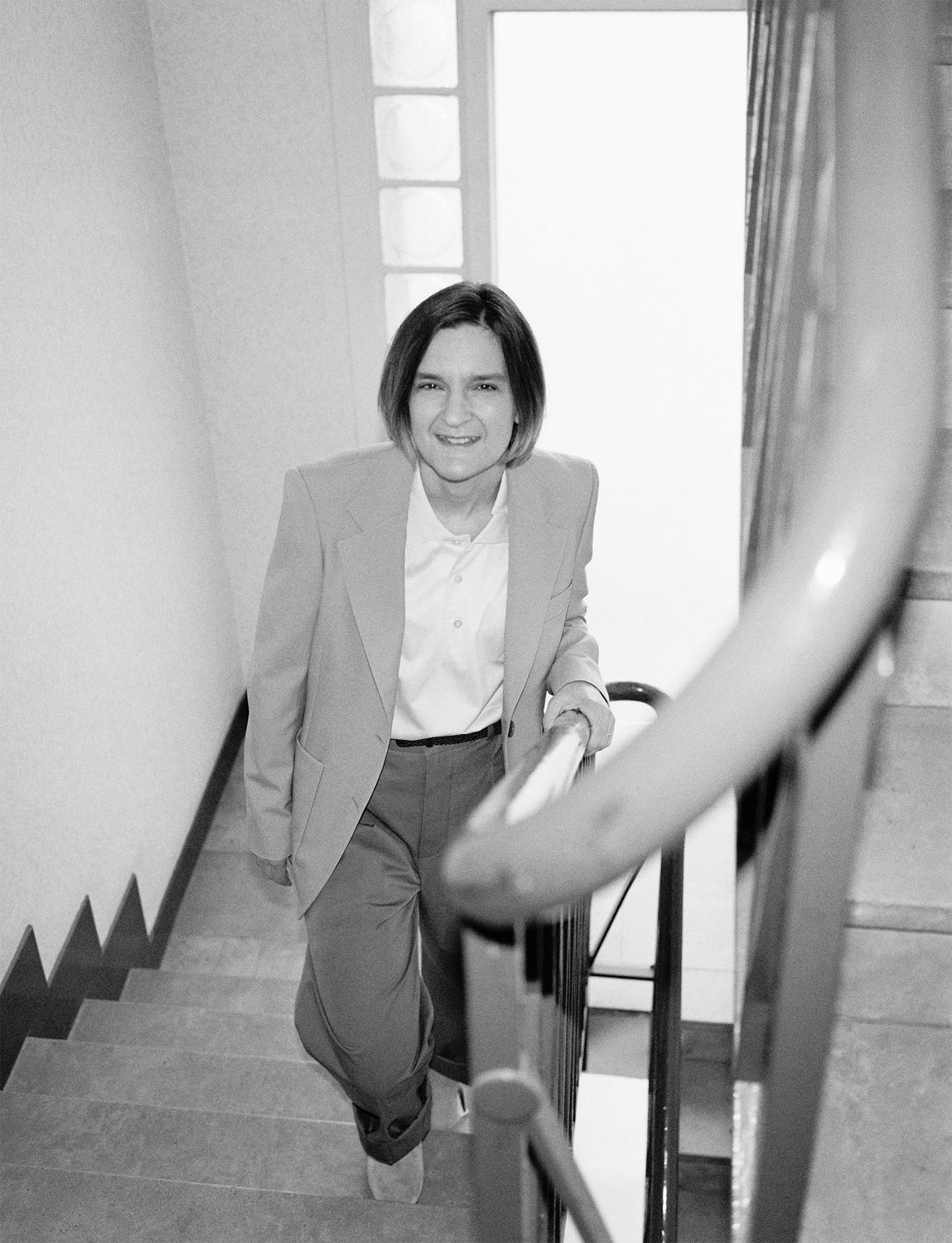Esther Duflo
The Nobel Prize-winning economist

An estimated 450 million of the world’s poorest people have benefited from the ideas of Esther Duflo, though the determinedly low-key economist isn’t one to boast. She prefers to stay in the background – whether at the Nobel Prize ceremony, where last December she became the youngest person ever to receive the award for economics, or when conducting the famous control trials in India on which her pragmatic work at MIT is based.
Such an attitude is essential to re-engaging with the people politics has left behind, the 47-year-old French American says – especially in a time when those communities are likely to dismiss scientific expertise like hers.
Esther Duflo, the renowned economist and recent Nobel laureate, is attempting to make lunch. We are in her father’s apartment in the 5th arrondissement of Paris, a neighbourhood of cobbled squares and wandering students, and the cupboards are unforgivably bare. After ransacking the kitchen like a thief, she has discovered eggs, cheese and bread. This will have to do. The predicament – making do with what you’ve got – somehow suits Esther. She’s a development economist engaged in the study of poverty and its remedies; this is her area. Esther likes to describe economics as “plumbing” – the execution of a practical service rather than the exposition of a grand theory. Her approach to her subject is empirical: propose a hypothesis, gather data, come up with a fix. So here’s her fix for lunch: fried eggs with a grind of pepper, a torn hunk of baguette, a wedge of cheese. For pudding – after a frantic five minutes searching in vain for chocolate and muttering under her breath “What’s wrong with this flat?” – black coffee.
Esther is in Paris, her hometown, with her husband, Abhijit Banerjee, a fellow economist and co-recipient of the Nobel, and their two children, Noémie, seven, and Milan, six. Normally, the family are based in Boston, where both Esther and Banerjee are professors at the Massachusetts Institute of Technology (MIT). They’ve come to France straight from the Nobel ceremony in Stockholm; a fantastically formal affair, it involved a full orchestra, lengthy speeches and the jewelled presence of the Swedish royal family. “Somewhat sur-real,” Esther says of the occasion, drawling beautifully in her heavy French accent.
At the ceremony, Esther and Banerjee opted not for the customary white tie but instead for traditional Indian dress: a blue sari for her, a tailored Bengali outfit of black bandhgala and off-white dhoti for him. She thought she’d cause a stir – a Parisian in Indian clothes – but “I was completely overshadowed, completely upstaged!” she says, laughing. By her Mumbai-born husband, she means. Banerjee was in all the Indian papers. “There was a whole page of ‘how to get the Banerjee look’,” Esther says. “All the accessories!” She doesn’t mind. According to Chiki Sarkar, her friend and the publisher of her books in India, she is determinedly low-key. “Abhijit is the voluble one. Esther stays in the background,” Sarkar told me over email. “And then you realise how extraordinary she is.”
“Extraordinary” is more fact than exaggeration in Esther’s case. At 46 (she has since turned 47), she was the youngest person ever to receive the prize for economics, and only the second woman, after Elinor Ostrom, who received it in 2009 for her analysis of economic governance. Esther was chosen – along with Banerjee and their associate Michael Kremer, the Gates Professor of Developing Societies at Harvard – in recognition of their “experimental approach to alleviating global poverty”, according to the official Nobel statement. This approach, which involves the use of practical experiments to test anti-poverty interventions, has transformed not only the field of development economics but also the way in which the many governments with which they collaborate, from Colombia to Côte d’Ivoire, help their poorest populations.

Photographed at her father’s home in Paris just days after receiving the Nobel Prize, Esther is wearing a grey wool jacket by STELLA McCARTNEY, green cotton pleated trousers by CRISTASEYA, and a yellow cotton polo shirt, a black elastic belt and beige suede slippers, all by CHARVET.
Eggs consumed, chocolate not found, Esther takes her coffee to the sofa and tucks her socked feet beneath her. She is small, 1 metre 60, and looks a decade younger than 47 in her spotty shirt and grey trousers, hair cut in a neat brown bob. She has the air of someone with little time for either formality or frivolity and in conversation is often serious and bracingly direct. Friends remarked on the unerring solemnity of her expression during the Nobel ceremony. “I forgot to smile,” she says and shrugs unapologetically, a momentary glint in her eyes revealing a dry humour. During the ceremony’s musical interludes, Esther found her mind wandering. “I started thinking about work and the logistics about bringing my kids to France, and then I was like, I’m getting the Nobel Prize! I need to come back in the moment!”
For Esther, high-minded academia and deep pragmatism coexist naturally. Banerjee told me that when they first started working together he noticed her “extraordinary ability to translate fairly abstract ideas into ‘This is how we’re going to do it.’” Her friend Sarkar adds that “essentially, she’s a doer as well as a thinker. She could have been a CEO.”
Near where Esther sits, a large window offers a Parisian fantasy view of jagged rooftops and chimney pots. Her children are on the other side of the city, in the suburban house where Esther grew up with her parents and where her mother still lives. For the past few days, they’ve all been walking everywhere because of the public transport strikes against pension reform that are causing chaos in the city and political pain for President Emmanuel Macron. When Esther’s Nobel win was announced, Macron was quick to leap on her success and tweeted (in French), “Esther Duflo’s magnificent Nobel Prize reminds us that French economists are the best in the world and shows that research in this field can have a concrete impact on the well-being of humanity.” Esther gives a half-smile. “His tweet omitted to mention that it was shared with two other people, and it also omitted the fact that I’ve lived in the US longer than I lived in France and that I’m an American citizen and all my career was done in the US,” she says, her tone loaded with irony. “So whether it’s a triumph of French science isn’t clear to me.”

“It was so incredibly fortunate that I was born where I was born. That gave me a responsibility to live my life well.”
To Esther’s eyes, the Nobel wasn’t simply a reward for individual academic work but a recognition of the “movement” that she and her colleagues have created. “It’s so much broader than us,” she insists. Their work is based on a methodology first developed in the mid-1990s by Kremer, who had the idea that economists could borrow the scientific tool of randomised control trials to measure the effectiveness of economic policies.
A randomised control trial involves testing a hypothesis by experimenting on two groups of people, one the recipient of a specific policy intervention, the other – the control – not. Take, for example, the study Esther and her colleagues conducted between 2004 and 2007 in 134 villages in the Udaipur district of Rajasthan in western India, where at the time only 1 per cent of children were fully immunised. The team established a control group of families for whom nothing was changed and compared them to a second group for whom a local camp was set up to make it easy to get children vaccinated monthly. But they also added a third group, members of which were given a kilo of lentils for each immunisation. The results were stark: having the nearby camp alone increased immunisations from 6 per cent to 17 per cent. Adding the lentils raised them to 38 per cent. “So here you have your answer,” Esther summarised in her 2010 TED Talk. “Make it easy and you multiply your immunisation rate by six.” Here was empirical evidence for a policy that would have a demonstrable effect on people’s lives, in direct contrast to spending untargeted money on a problem and hoping it goes away.

Here and in the previous image, Esther wears a grey linen and double-faced crêpe wool jacket by AKRIS, a beige cotton shirt by LEMAIRE, olive twill pleated trousers by MARGARET HOWELL and a black belt by CHARVET.
Esther knew early on that if they wanted their work to last, they would need institutional heft and a place where researchers from all over the world could work together. So, in June 2003, Esther, Banerjee and Sendhil Mullainathan (now a professor of computational and behavioural science at the University of Chicago) founded the Poverty Action Lab at MIT. Two years later it received a major endowment from Mohammed Abdul Latif Jameel in honour of his father, a prominent Saudi entrepreneur. Today the Abdul Latif Jameel Poverty Action Lab (J-PAL) has a network of 194 affiliated professors at 62 universities on every continent. And there is also J-PAL North America, established seven years ago to work exclusively on anti-poverty policies in the US. In that time, it has examined a range of issues in the richest country in the world, including access to health insurance and the impact of growing up in a particular town or neighbourhood. “It hit the ground running,” Esther says of J-PAL North America, “and there is enormous demand for the work.” She calculates that worldwide, 450 million people have been directly affected by policies that J-PAL affiliates have evaluated and found to be effective.
J-PAL occupies a large red-brick, modern block on Main Street in Cambridge, Massachusetts, round the corner from other MIT faculties, such as the Department of Earth, Atmospheric and Planetary Sciences and the Koch Institute for Integrative Cancer Research. In the space of a square mile, it feels as if all the world’s problems are being wrestled into submission. When she’s in the office, Esther manages large-scale research projects, edits the American Economic Review (one of the most prestigious journals in the field) and engages with J-PAL’s international network of researchers. Her choice of the word “movement” to describe this group is not accidental. “A movement is going somewhere, absolutely,” she says. “It’s a movement of people with different paths and very different expertise, and it’s all going towards the same place – to make the lives of poor people better here and now.”
Esther cares about visible, tangible, immediate change rather than abstract idealism. J-PAL has to work with any government that employs it to evaluate its policies, regardless of political persuasion. But the politics of her work is unavoidable, and her recent bestselling book, written with Banerjee, Good Economics for Hard Times, is, Esther concedes, “very political, but it’s not ideological.”
Their work has been attacked from all sides. Prior to its publication in November, the book was reviewed in The Guardian by Yanis Varoufakis, the ex-minister of finance in Greece. “Nice analysis of things, but oh, they are still in love with the market, it doesn’t go far enough,” Esther sums up. She shrugs. “Then William Easterly [a professor at NYU who has argued against the provision of state aid] reviewed it for The Wall Street Journal and said, ‘Oh, nice analysis of many things, but really they are too left-wing.’” She looks amused. The nature of her work, she sometimes feels, is to please no one. It is attacked from the right for promoting state intervention when the market should be left to its own devices, and from the left for tinkering with policies while ignoring deeper political and institutional issues.
Her political leanings come across clearly in conversation: she is an avowed supporter of redistribution of wealth and takes issue with the right-wing tendency to demonise the poor as irresponsible or lazy. A central irony of her work is that she often seeks to serve people who have, in recent years, repeatedly voted against policy programmes that her research supports. Victories for Donald Trump and Boris Johnson are a result, in Esther’s view, of left-of-centre parties such as Labour in the UK, the Democrats in the US and the socialist party in France having abandoned the economic interests of the people they traditionally represented.
“So they’re holding the short end of the sticks,” she explains, referring to those who feel left behind by such parties. “They are very sceptical of any economic discourse that pretends to do well for them because they have not been doing well for years and years and years and years.” Nancy Rose, the head of the Economics Department at MIT, tells me that “the first quality that comes across when you interact with Esther is her passion, and her ability to connect on a very human scale.” Esther argues fervently for restoring the dignity of those in poverty and trusting them to make the right decisions for themselves and their families. Politicians need to re-engage with those who have been left behind, ask them what they need, trust their responses and act on them. Direct contact with the people you are trying to help is vital, she says, “because without that direct exposure, you lose touch.”
Esther doesn’t get as much time to do field work as she used to – she is too busy managing other people’s projects – but she travels when she can. (On a recent field trip, in October 2018, she took her then five-and-a-half-year-old daughter with her to visit villages in Rajasthan.)
It isn’t just the engagement of politicians that Esther has to grapple with. A new problem is that scientifically tested evidence has never been less fashionable, or more manipulated. Academics are casually derided by populist politicians (“I think the people in this country have had enough of experts,” the Conservative cabinet minister and leading Brexiteer Michael Gove said, chillingly, in the run-up to the EU referendum in 2016). The undermining of expertise “came up many times in the speeches of the Swedes,” Esther says, referring to the Nobel ceremony. “Right now is a time when science is questioned.”
Despite this, Esther remains determinedly optimistic. “Being a development economist is a source of hope,” she insists. “If you look at the geopolitical situation, the one thing that has gone very well in the last 30 years is, the plight of the poorest in the world has really improved. Absolute poverty has been halved, maternal mortality has been halved, infant mortality has been halved, almost all of the kids are in school [in developing countries]. And some of it is due to economic growth, which we didn’t influence, but some of it is due to greater policy focus on these issues and greater pragmatism. And I think we are a small part of that pragmatism.”
This is as close as Esther gets to taking credit. For someone who has achieved a preposterous amount in a very short time, she is stubbornly modest. Remembering herself as a child, she says – in a way that is not so much boastful as truthful – that while she was bad at sport, music, drama and essentially anything non-academic, she was always “very good at school. I decided, very early, maybe aged eight, that I would be a historian.”
Her parents were both hugely influential. Esther’s father, Michel Duflo, is a mathematician, and her mother, Violaine, is a paediatrician who would spend a few weeks each year working with victims of civil war in places such as Morocco, El Salvador, Madagascar and Rwanda. The part of Esther that wants to help, and to feel physically connected to the people she is trying to help, comes directly from Violaine.
As a teenager, Esther passed the exams to enter the prestigious École normale supérieure, for the brightest students in France. There, in her third year, she took economics as an additional subject to diversify her studies and because she thought it would be a good complement to history. This prompted her only period of self-doubt. “I didn’t like economics,” she recalls. “I thought it was so stupid. The way of taking your intuitions and putting some silly maths around it? What’s the point?
“I had a strong sense that one needs to live one’s life to justify one’s luck,” she says frankly. “It was so incredibly fortunate that I was born where I was born; I could have been born a little girl in Congo. That gave me a responsibility to live my life well. I cannot remember a time when that was not weighing on me in some sense.” Economics didn’t quite cut it, nor did history. For the first time, she wasn’t sure what to do with herself. What she did was to take a year out and spend it in Moscow as the “research assistant of the research assistant of some economist. So a very kind of low position.” But it was a position that happened to be in the Bank of Russia. This was 1993, when the country was in economic free fall. “I didn’t necessarily agree with what they were doing,” Esther says, “but I could see they were powerful. At the same time, it was a bit scary because they were playing with fire.” Economists, she realised, didn’t have to be disengaged from on-the-ground reality; they could shape it.
Esther returned to France, finished her degree and then did a master’s in economics, also in Paris. She then applied to do a PhD at MIT – arguably the most prestigious place in the world to study economics. Once there, she discovered her true calling in the form of development economics. Banerjee was one of her professors, and he vividly recalls his first impression of Esther in class. “It was very clear that she was extraordinarily clever, and she said all kinds of perceptive things,” he told me. “We get many, many super-bright students at MIT, but what is rare is when they have a real way of connecting class material to the world. That was always right there from day one. That’s who she is; she’s very strongly located in the world and also very able to understand abstractions.”
After her PhD, Esther joined the faculty at MIT, in a move that was considered unusual – academics don’t typically take their first position at the institution where they went to graduate school. MIT’s reputation was seductive, though. Esther makes it sound like the opportunity was a fluke of timing. Kremer had just left for Harvard, there was an opening, and she happened to be in the right place at the right time. In fact, she had job offers from everywhere – “Harvard, Berkeley or whatnot” – and decided to accept MIT’s because she knew she wanted to pursue the work on randomised control trials, “and if I had gone anywhere else I would have to justify why it’s not nuts.” At 29, she became one of the youngest MIT faculty members to hold tenure. “It seemed to be a no-brainer; it was just the best, best place,” she says. “And it has proven to be one of the fortunate events of my life.”
She means this in a professional sense, but I point out that MIT has also been the basis of her entire personal life. She smiles. “That only took place many, many years later,” she says. She and Banerjee married in 2015 and now live with their children in a red-brick, wood-floored townhouse in downtown Boston, from where Esther goes running regularly along the Charles River. “It’s all a constant mingling in both directions,” she says. “We could be talking about home issues at work and work issues at home. I think it works very well. Every work relationship has tension, and every marriage relationship has tensions, but the mingling I see as a plus.” (It also seems to be the norm; Nancy Rose told me that Esther and Banerjee are one of four married couples within the MIT Economics Department.) According to their friend Chiki Sarkar, she’ll sort out the children; he’ll cook. They take it in turns to write chapters of their books. “There is a lot of co-ordination,” Sarkar says.
Both Esther and Banerjee are big readers. At the Nobel ceremony, they befriended the 2018 literature prizewinner, Olga Tokarczuk. Her novel Flights is next on Esther’s reading list. “Abhijit has read all her books and says they are wonderful.” Before she gets to that, she must finish the unlikely combination of the most recent John le Carré novel, Agent Running in the Field, and Winners Take All: The Elite Charade of Changing the World, Anand Giridharadas’s account of how the global super-rich pretend to help others but in fact maintain the status quo to help themselves. A lesson, perhaps, in what not to do.
Beyond reading, there is little time. “What rest of my life?” she asks. Their children, she says, understand what they do. Not long ago, Milan made a contraption out of magnetised tiles that he told her was a “machine to make money to give to the poor”. In a way, it’s a neat description of what his mother has already done, not just in the practice of her work but in how it has been rewarded. The Nobel Prize is worth 9 million Swedish kronor (about £720,000), and Esther, Banerjee and Kremer decided to give their winnings to the Weiss Fund, which supports US graduate students doing research in development economics. “Alan Weiss matched it with $50 million,” Esther told me, which means support can now be extended to researchers in Europe and the developing world. Theirs is a small offering, Esther says, her modesty somehow not suited to the scale of their generosity, “but it’s one example where we are trying to use the Nobel Prize to further the movement.”
In Esther’s mind, such a donation is logical. It’s the CEO in her: invest in what works and watch it grow. It’s also in keeping with her determined practicality: there needs to be more research, and research requires funding. What else would you do except give your winnings to the cause? It’s just another little fix, a perfectly effective piece of plumbing.

Here, the sun-khaki cotton-and-nylon trench coat is by VINCE. In the opening image, the olive cotton blazer is by MARGARET HOWELL, the lilac cotton shirt is CHARVET and the green cotton trousers are CRISTASEYA.
Sophie ElmhirstLondon based journalist Sophie is a regular contributor to the Guardian, The New York Times, the New Yorker and the Financial Times. Honours in the Elmhirst cabinet include a British Journalism Award for feature writer of the year and a Foreign Press Association award for finance and economics story…read more Portraits by
Andrea Spotorno The Italian photographer Andrea Spotorno is a regular contributor to magazines such as Purple magazine, Fantastic Man, Numèro and Another Magazine. He has also shot for brands including Céline, Hermès and Valentino. With perhaps the firmest handshake in fashion, Andrea lives in Paris where he is…read more
Styling: Hisato Tasaka. Hair: Rimi Ura at Walter Schupfer Management. Make-up: Mayumi Oda at Calliste Agency. Photographic assistance: Lisa Marleen Müller. Production: Bird Production.
This profile was originally published in The Gentlewoman nº 21, Spring & Summer 2020.